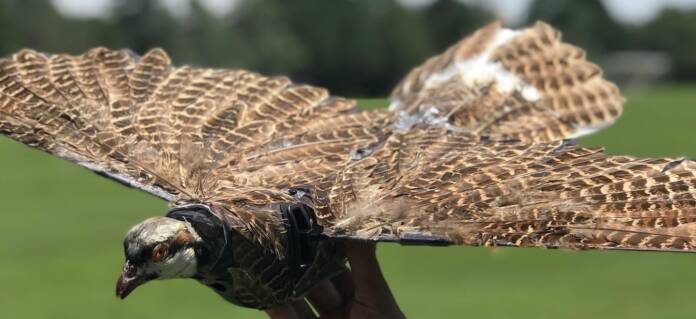
Hassanalian is studying the way the bird drones move in flight in hopes that the findings can improve aviation technology.
“We want to fly them and flap them similar to birds to understand the physics,” Hassanalian said, adding that the lessons might someday have relevance for the aviation industry.
Hassanalian, who began his engineering studies in Iran before moving to New Mexico to pursue a PhD, has always loved watching birds. He was amazed by how they have evolved to master flying and hoped to one day invent drones that could mimic their flight patterns.
Last spring, Hassanalian ordered a handful of ornithopters — small machines with mechanical wings that flap like those of birds and insects — and placed wings, feathers and heads from taxidermied birds onto them. When he tossed them into the air from the Socorro, N.M., university’s field, they flew for a few minutes.
Hassanalian said he spent about $200 on each bird and tested wings from pigeons, hummingbirds and crows on a flapping simulator for their ability to endure stress and speed.
Hassanalian then settled on two types of motors to be placed inside the birds. One generates a flapping motion; the other helps the bird glide with straight wings. Hassanalian said he has discovered that many birds are adept at flapping, but birds with wings lower on their bodies, such as albatrosses, flap less frequently and are best for gliding. By studying both, scientists hope to enhance aviation technology regardless of their flight mechanisms.
The drones’ batteries allow them to fly for between 10 and 20 minutes, but Hassanalian said he’s working on energy-saving tactics that will prolong flight times. Researchers are studying how the color of birds’ feathers affects how much energy they exert and how fast they can fly. That could set new industry standards for which colors aircraft and other vehicles should use.
“There may be a certain color pattern that’s most efficient for a car driving down the road, but that same color pattern is not very good for a plane flying or a bird flapping,” said researcher Brenden Herkenhoff, a PhD student at New Mexico Institute of Mining and Technology.
Scientists say the drones could also offer environmental benefits. Drones that look like birds could someday fly alongside migrating birds to learn their flight patterns and behavior, though Hassanalian said he’s unsure whether other birds will notice the drones aren’t alive — or whether hawks or eagles might try to attack them.
The drones might also better monitor birds and other animals in their habits without spooking them, as some large, loud aircraft do today.
“The other application for this is to understand how birds communicate with each other, how they escape from predators,” Hassanalian said. “These are all unknowns that we can learn through this technology.”
Engineers have previously used bird drones as a form of surveillance. During the Cold War, the CIA built a bird-size drone to try to spy on the Soviet Union. In 2018, China reportedly developed drones that appeared as doves to monitor citizens. An ironic Gen Z-devised conspiracy theory hypothesizes that the U.S. government created birds to supervise Americans.
Hassanalian acknowledged some might want to use his drones for surveillance once they’re more advanced. But he hopes their most significant impact will come elsewhere.
“This can create a revolution in the aviation industry,” Hassanalian said.














